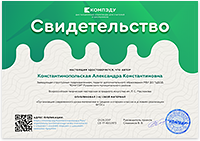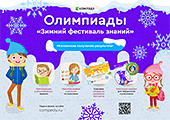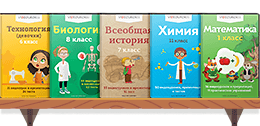
Prepared by Y.L.Ter-Semyonova
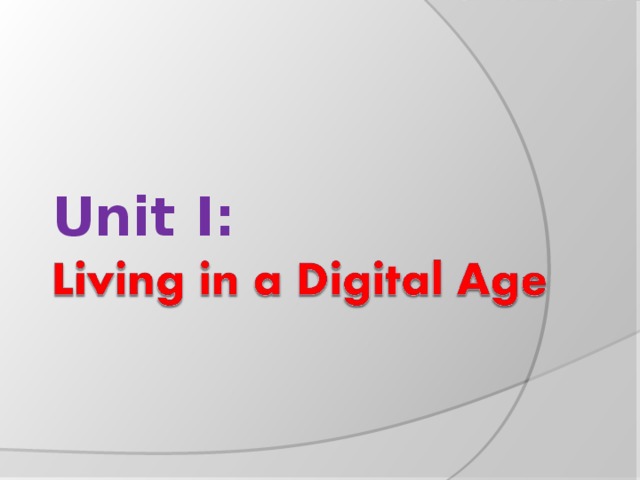
Unit I:
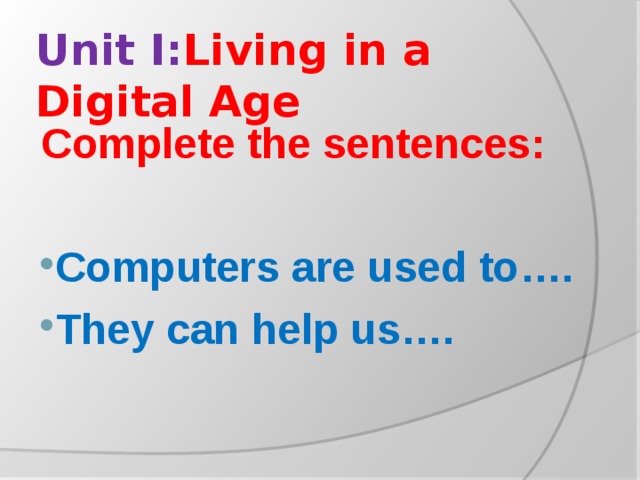
Unit I: Living in a Digital Age
Complete the sentences:
- Computers are used to….
- They can help us….
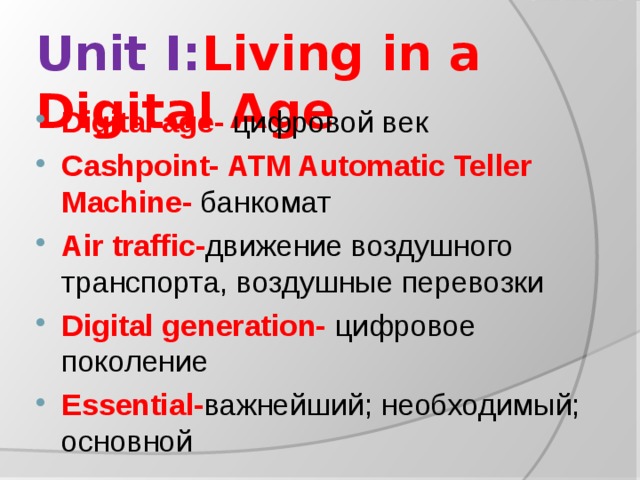
Unit I: Living in a Digital Age
- Digital age- цифровой век
- Cashpoint- ATM Automatic Teller Machine- банкомат
- Air traffic- движение воздушного транспорта, воздушные перевозки
- Digital generation- цифровое поколение
- Essential- важнейший; необходимый; основной
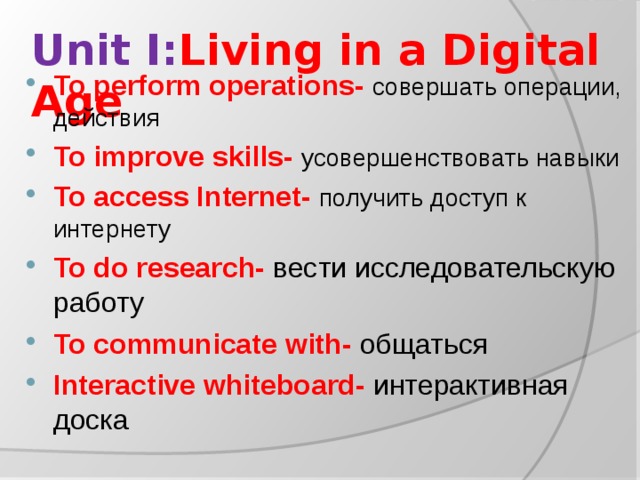
Unit I: Living in a Digital Age
- To perform operations- совершать операции, действия
- To improve skills- усовершенствовать навыки
- To access Internet- получить доступ к интернету
- To do research- вести исследовательскую работу
- To communicate with- общаться
- Interactive whiteboard- интерактивная доска
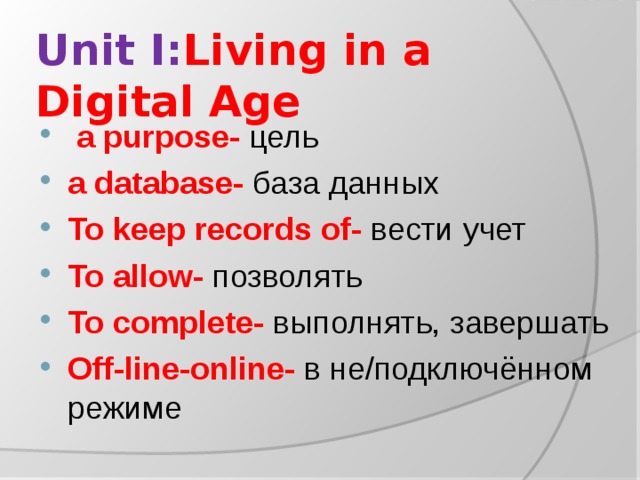
Unit I: Living in a Digital Age
- a purpose- цель
- a database- база данных
- To keep records of- вести учет
- To allow- позволять
- To complete- выполнять, завершать
- Off-line-online- в не/подключённом режиме
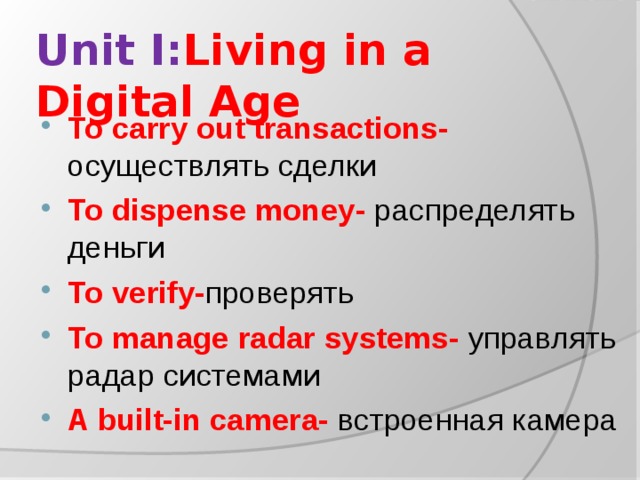
Unit I: Living in a Digital Age
- To carry out transactions- осуществлять сделки
- To dispense money- распределять деньги
- To verify- проверять
- To manage radar systems- управлять радар системами
- A built-in camera- встроенная камера
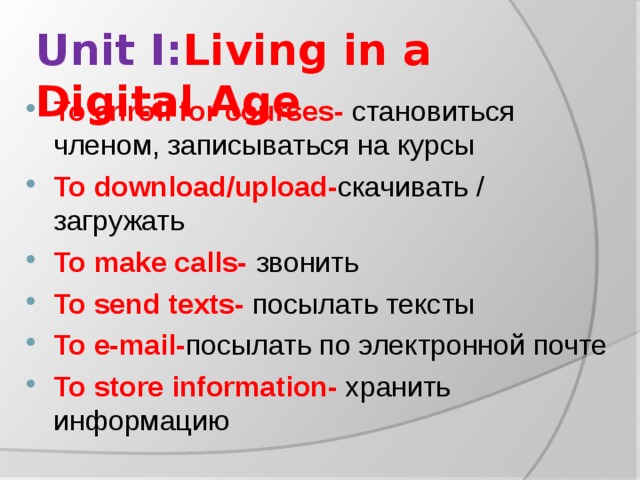
Unit I: Living in a Digital Age
- To enroll for courses- становиться членом, записываться на курсы
- To download/upload- скачивать / загружать
- To make calls- звонить
- To send texts- посылать тексты
- To e-mail- посылать по электронной почте
- To store information- хранить информацию

Unit I: Living in a Digital Age
- To enter PIN (also PIN number) (personal identification number)- набрать личный ПИН-код (в различных электронных, в частности, банковских системах)
- To pay bills- оплачивать счета
- To transfer money- переводить деньги
- To display data- показывать, высвечивать на экране данные
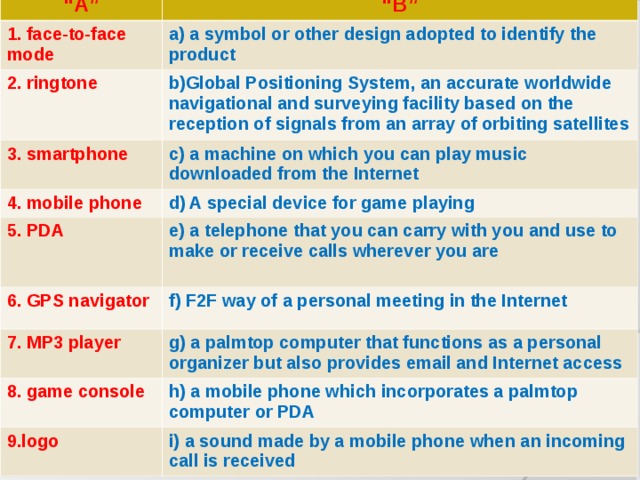
“ A”
“ B”
1. face-to-face mode
2. ringtone
a) a symbol or other design adopted to identify the product
3. smartphone
b)Global Positioning System, an accurate worldwide navigational and surveying facility based on the reception of signals from an array of orbiting satellites
c) a machine on which you can play music downloaded from the Internet
4. mobile phone
5. PDA
d) A special device for game playing
e) a telephone that you can carry with you and use to make or receive calls wherever you are
6. GPS navigator
7. MP3 player
f) F2F way of a personal meeting in the Internet
8. game console
g) a palmtop computer that functions as a personal organizer but also provides email and Internet access
h) a mobile phone which incorporates a palmtop computer or PDA
9.logo
i) a sound made by a mobile phone when an incoming call is received


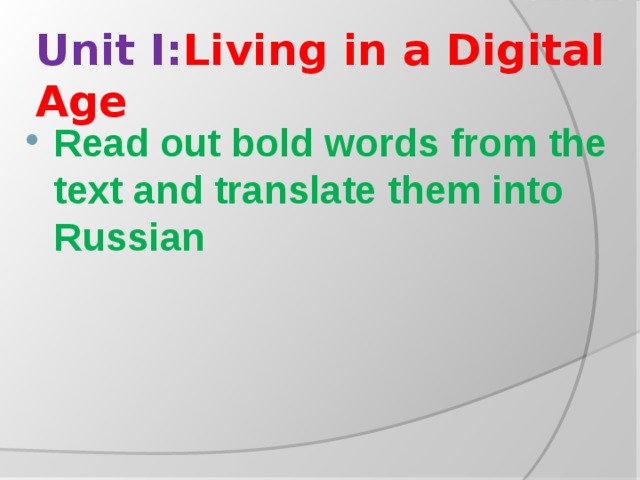
Unit I: Living in a Digital Age
- Read out bold words from the text and translate them into Russian





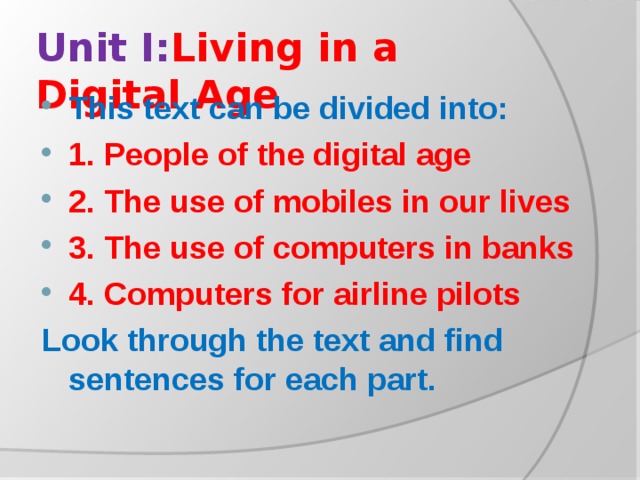
Unit I: Living in a Digital Age
- This text can be divided into:
- 1. People of the digital age
- 2. The use of mobiles in our lives
- 3. The use of computers in banks
- 4. Computers for airline pilots
Look through the text and find sentences for each part.
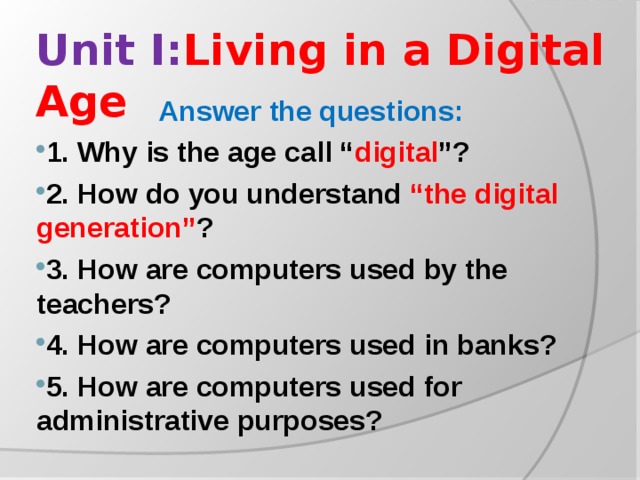
Unit I: Living in a Digital Age
Answer the questions:
- 1. Why is the age call “ digital ”?
- 2. How do you understand “the digital generation” ?
- 3. How are computers used by the teachers?
- 4. How are computers used in banks?
- 5. How are computers used for administrative purposes?

Unit I: Living in a Digital Age
- 6. How are mobiles used in our lives?
- 7. What is the difference between smartphones and mobiles?
- 8. What is PDA ?
- 9. Why are computers used in banks to store the information?
- 10. What is ATM ?
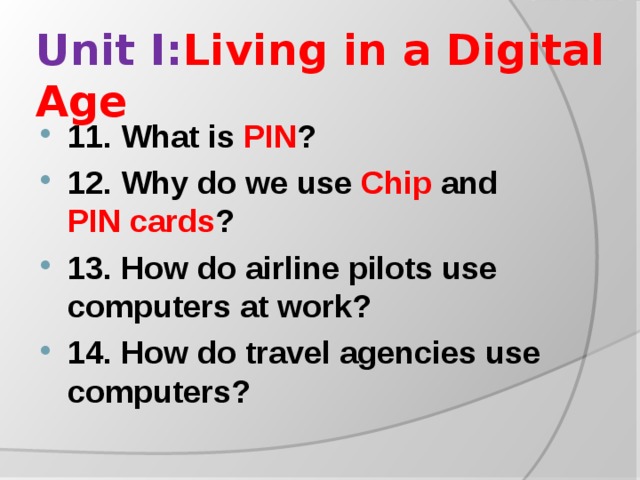
Unit I: Living in a Digital Age
- 11. What is PIN ?
- 12. Why do we use Chip and PIN cards ?
- 13. How do airline pilots use computers at work?
- 14. How do travel agencies use computers?
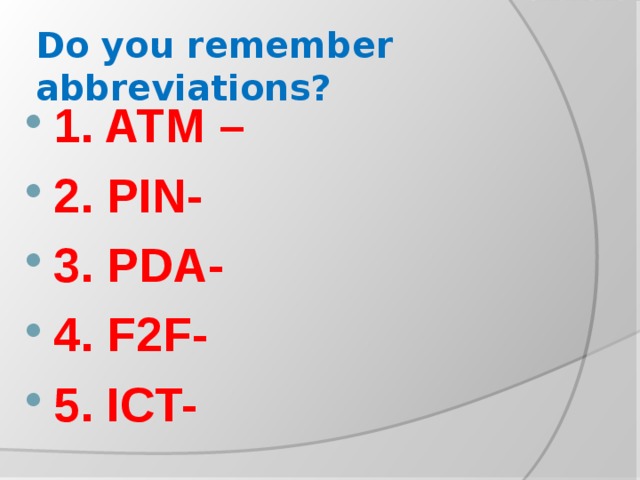
Do you remember abbreviations?
- 1. ATM –
- 2. PIN-
- 3. PDA-
- 4. F2F-
- 5. ICT-





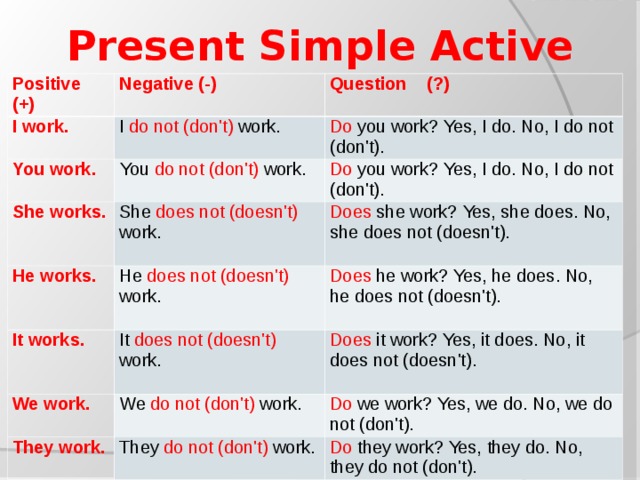
Present Simple Active
Positive (+)
Negative (-)
I work.
Question (?)
I do not (don't) work.
You work.
Do you work? Yes, I do. No, I do not (don't).
You do not (don't) work.
She works.
Do you work? Yes, I do. No, I do not (don't).
She does not (doesn't) work.
He works.
It work s .
Does she work? Yes, she does. No, she does not (doesn't).
He does not (doesn't) work.
Does he work? Yes, he does. No, he does not (doesn't).
It does not (doesn't) work.
We work.
Does it work? Yes, it does. No, it does not (doesn't).
We do not (don't) work.
They work.
Do we work? Yes, we do. No, we do not (don't).
They do not (don't) work.
Do they work? Yes, they do. No, they do not (don't).

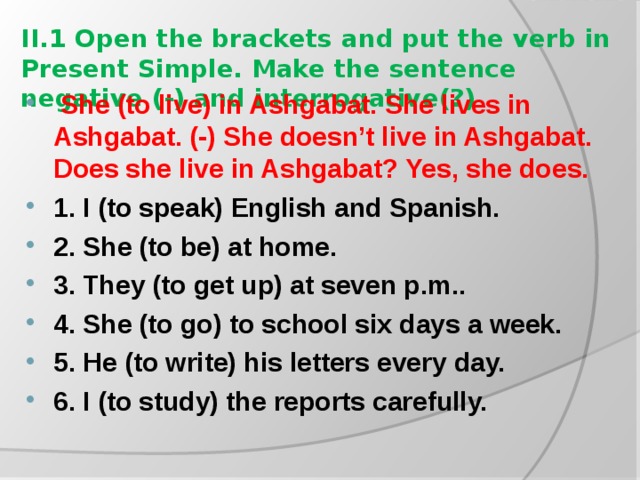
II.1 Open the brackets and put the verb in Present Simple. Make the sentence negative (-) and interrogative(?)
- She (to live) in Ashgabat. She lives in Ashgabat. (-) She doesn’t live in Ashgabat. Does she live in Ashgabat? Yes, she does.
- 1. I (to speak) English and Spanish.
- 2. She (to be) at home.
- 3. They (to get up) at seven p.m..
- 4. She (to go) to school six days a week.
- 5. He (to write) his letters every day.
- 6. I (to study) the reports carefully.
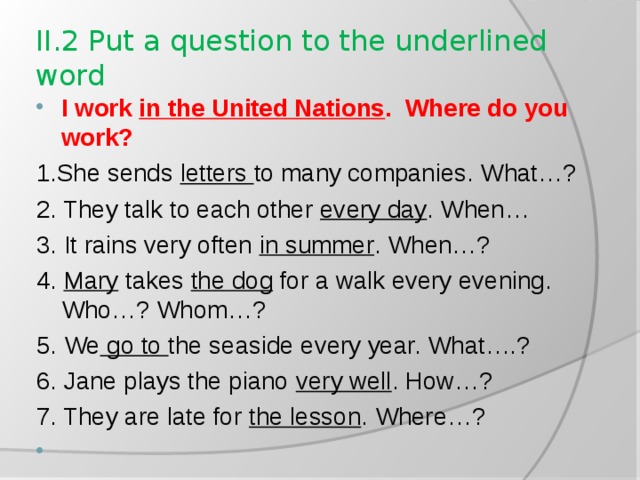
II.2 Put a question to the underlined word
- I work in the United Nations . Where do you work?
1.She sends letters to many companies. What…?
2. They talk to each other every day . When…
3. It rains very often in summer . When…?
4. Mary takes the dog for a walk every evening. Who…? Whom…?
5. We go to the seaside every year. What….?
6. Jane plays the piano very well . How…?
7. They are late for the lesson . Where…?
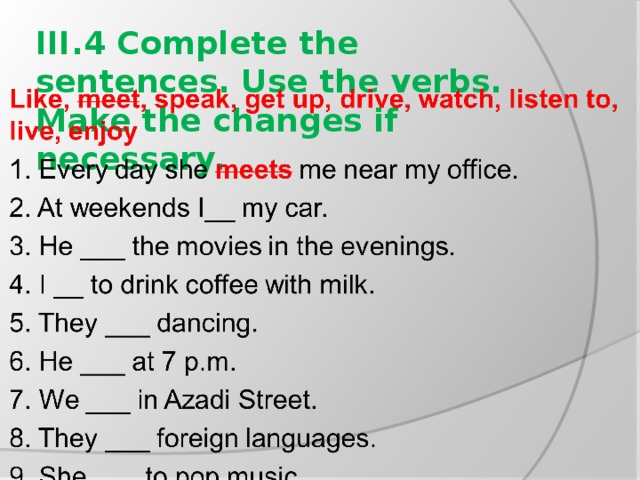
III.4 Complete the sentences. Use the verbs. Make the changes if necessary.
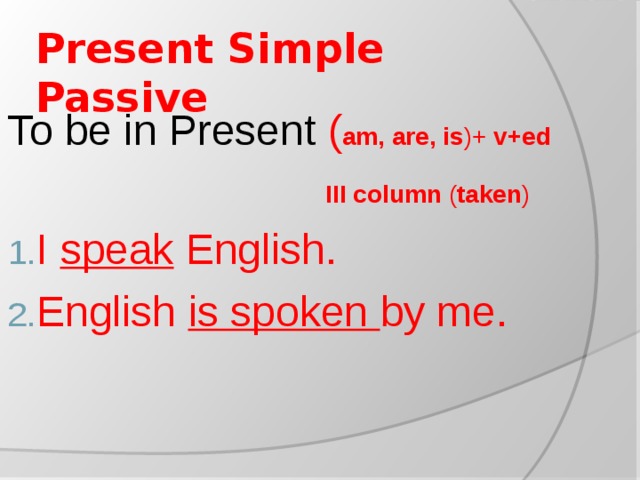
Present Simple Passive
To be in Present ( am, are, is )+ v+ed
III column ( taken )
- I speak English.
- English is spoken by me.
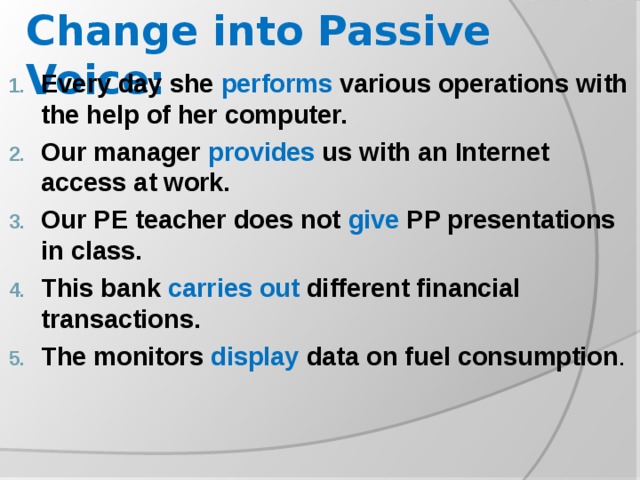
Change into Passive Voice:
- Every day she performs various operations with the help of her computer.
- Our manager provides us with an Internet access at work.
- Our PE teacher does not give PP presentations in class.
- This bank carries out different financial transactions.
- The monitors display data on fuel consumption .
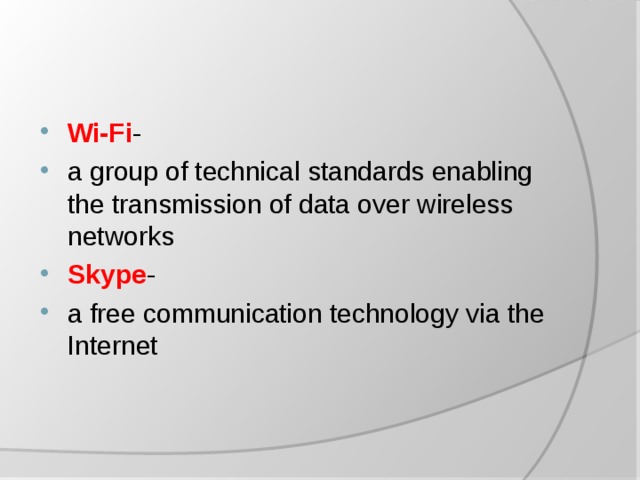
- Wi-Fi -
- a group of technical standards enabling the transmission of data over wireless networks
- Skype -
- a free communication technology via the Internet


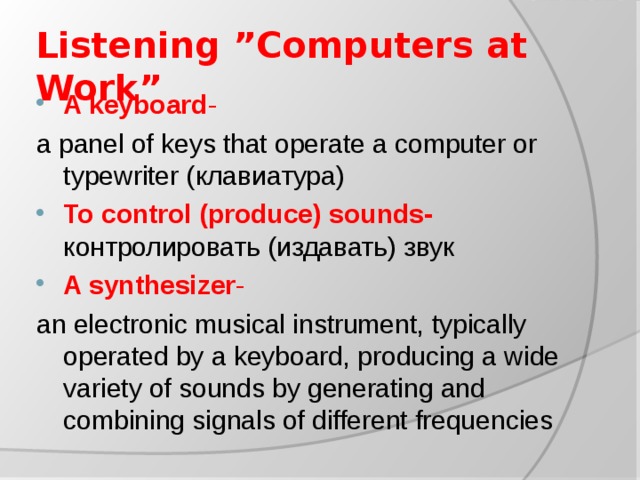
Listening ”Computers at Work”
- A keyboard -
a panel of keys that operate a computer or typewriter ( клавиатура )
- To control (produce) sounds- контролировать (издавать) звук
- A synthesizer -
an electronic musical instrument, typically operated by a keyboard, producing a wide variety of sounds by generating and combining signals of different frequencies
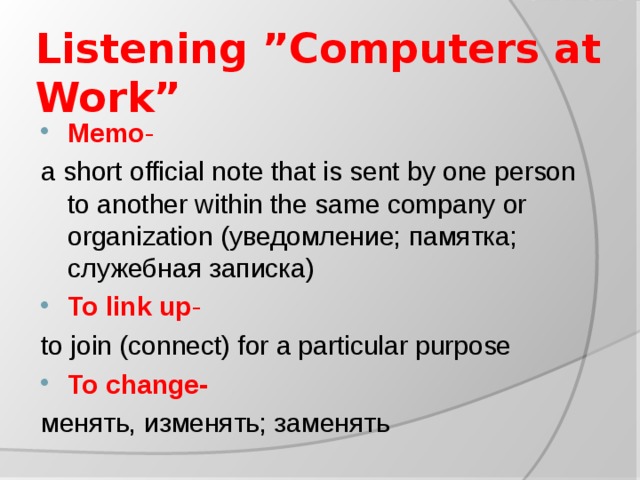
Listening ”Computers at Work”
- Memo -
a short official note that is sent by one person to another within the same company or organization (уведомление; памятка; служебная записка)
- To link up -
to join (connect) for a particular purpose
- To change-
менять, изменять; заменять
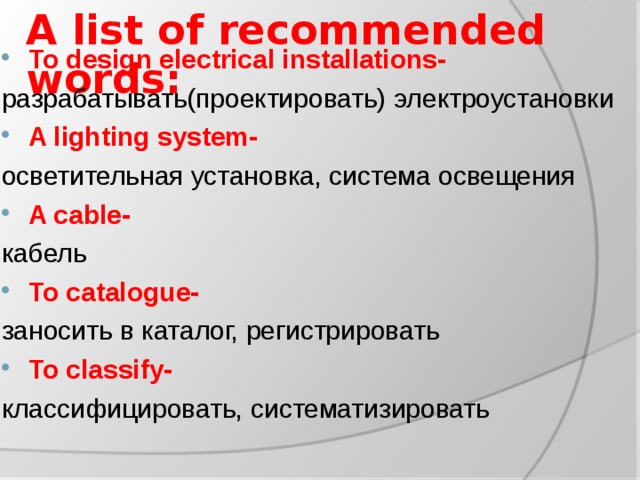
A list of recommended words:
- To design electrical installations-
разрабатывать(проектировать) электроустановки
- A lighting system-
осветительная установка, система освещения
- A cable-
кабель
- To catalogue-
заносить в каталог, регистрировать
- To classify-
классифицировать, систематизировать

A list of recommended words:
- To assist-
to help (someone), typically by doing a share of the work
- A hardware -
machines or tools themselves as opposed to the programs which tell the machines what to do.
- A software -
the programs and other operating information used by a computer
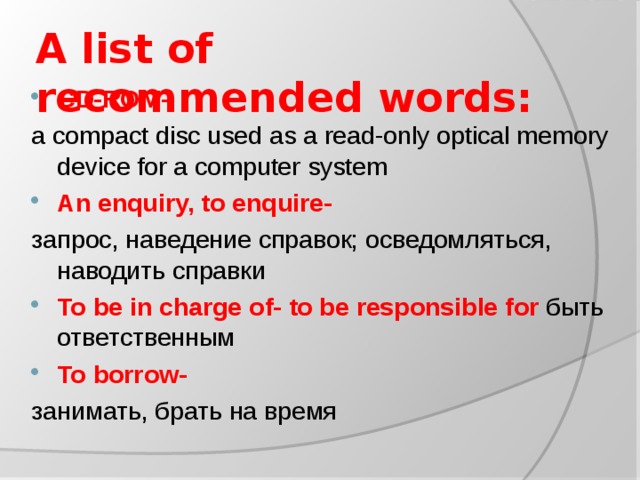
A list of recommended words:
- CD-ROM-
a compact disc used as a read-only optical memory device for a computer system
- An enquiry, to enquire-
запрос, наведение справок; осведомляться, наводить справки
- To be in charge of- to be responsible for быть ответственным
- To borrow-
занимать, брать на время


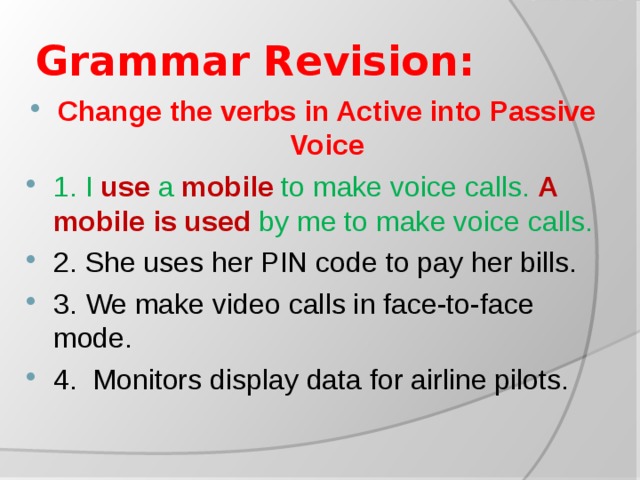
Grammar Revision:
- Change the verbs in Active into Passive Voice
- 1. I use a mobile to make voice calls. A mobile is used by me to make voice calls.
- 2. She uses her PIN code to pay her bills.
- 3. We make video calls in face-to-face mode.
- 4. Monitors display data for airline pilots.

Grammar Revision:
- 5. People call our century as “digital age”.
- 6. My computer stores the important information.
- 7. IT specialists perform various technical operations.
- 8. I write memos in my smartphone.
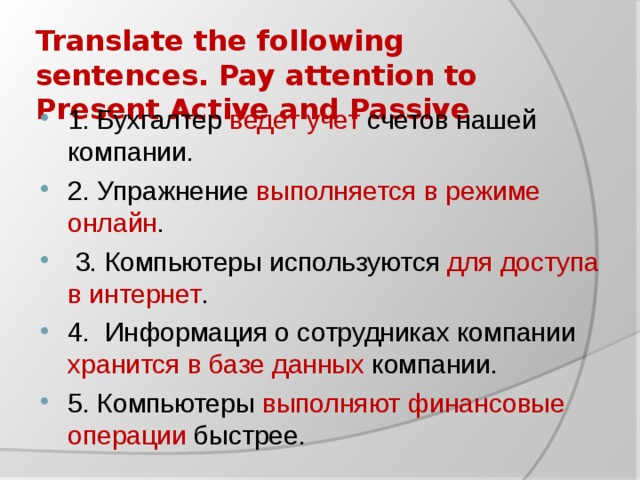
Translate the following sentences. Pay attention to Present Active and Passive
- 1. Бухгалтер ведет учет счетов нашей компании.
- 2. Упражнение выполняется в режиме онлайн .
- 3. Компьютеры используются для доступа в интернет .
- 4. Информация о сотрудниках компании хранится в базе данных компании.
- 5. Компьютеры выполняют финансовые операции быстрее.
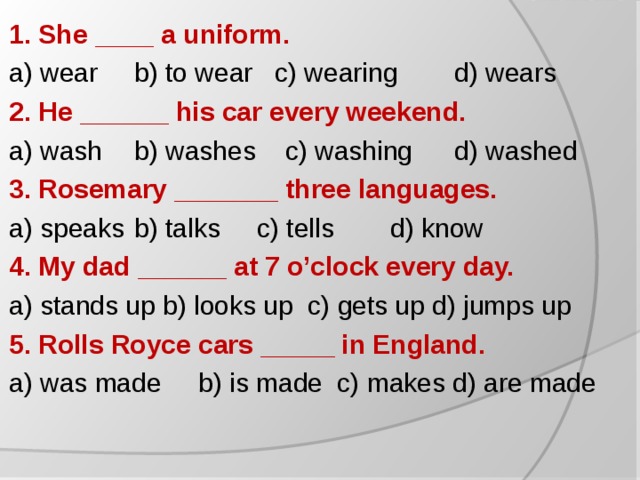
1. She ____ a uniform.
a) wear b) to wear c) wearing d) wears
2. He ______ his car every weekend.
a) wash b) washes c) washing d) washed
3. Rosemary _______ three languages.
a) speaks b) talks c) tells d) know
4. My dad ______ at 7 o’clock every day.
a) stands up b) looks up c) gets up d) jumps up
5 . Rolls Royce cars _____ in England.
a) was made b) is made c) makes d) are made
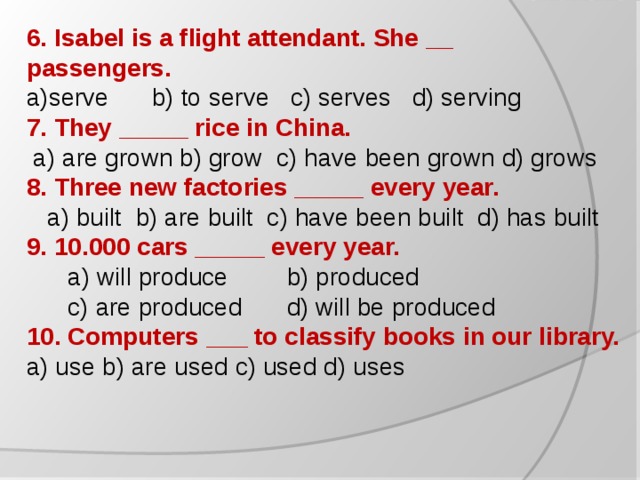
6. Isabel is a flight attendant. She __ passengers.
- serve b) to serve c) serves d) serving
7. They _____ rice in China.
a) are grown b) grow c) have been grown d) grows
8. Three new factories _____ every year.
a) built b) are built c) have been built d) has built
9. 10.000 cars _____ every year.
a) will produce b) produced
c) are produced d) will be produced
10. Computers ___ to classify books in our library.
a) use b) are used c) used d) uses




UNIT II “COMPUTER ESSENTIALS”
- 1. CPU (inside)-
Central Processing Unit
a part of the computer that processes all the data and makes the computer work.
2. DVD drive-
a Digital Video Disc drive
a disc on which a film or music is recorded.
дисковод (компакт-дисков формата)
3. USB port- a “Universal Serial Bus” port
a type of serial port for connecting peripheral devices in a system ( порт универсальной последовательной шины )

UNIT II “COMPUTER ESSENTIALS”
- 4. external broadband modem or router-
внутренний широкополосный модем, маршрутизатор
a piece of equipment which allows access to other computers or networks, for example the Internet.
5. keyboard-
a panel of keys that operate a computer or typewriter ( клавиатура )
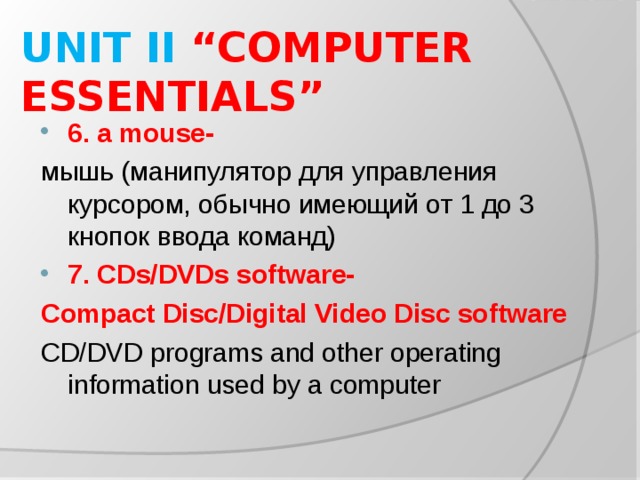
UNIT II “COMPUTER ESSENTIALS”
- 6. a mouse-
мышь (манипулятор для управления курсором, обычно имеющий от 1 до 3 кнопок ввода команд)
- 7. CDs/DVDs software-
Compact Disc/Digital Video Disc software
CD/DVD programs and other operating information used by a computer
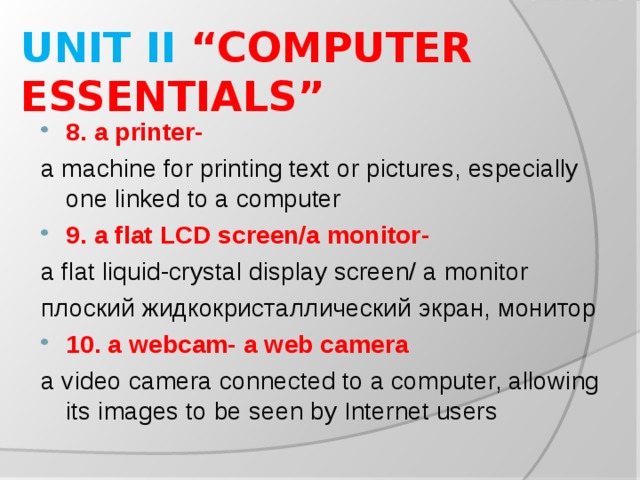
UNIT II “COMPUTER ESSENTIALS”
- 8. a printer-
a machine for printing text or pictures, especially one linked to a computer
- 9. a flat LCD screen/a monitor -
a flat liquid-crystal display screen/ a monitor
плоский жидкокристаллический экран, монитор
- 10. a webcam- a web camera
a video camera connected to a computer, allowing its images to be seen by Internet users
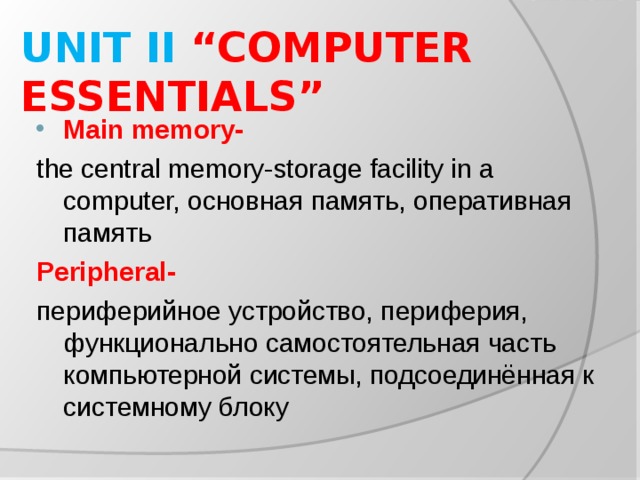
UNIT II “COMPUTER ESSENTIALS”
- Main memory-
the central memory-storage facility in a computer, основная память, оперативная память
Peripheral-
периферийное устройство, периферия , функционально самостоятельная часть компьютерной системы, подсоединённая к системному блоку
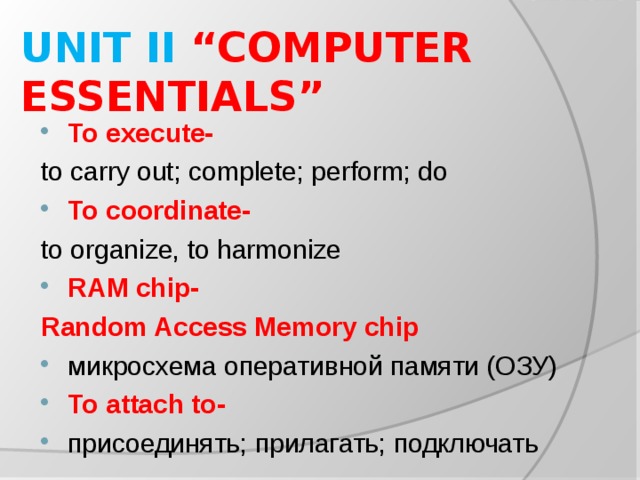
UNIT II “COMPUTER ESSENTIALS”
- To execute-
to carry out; complete; perform; do
- To coordinate-
to organize, to harmonize
- RAM chip-
Random Access Memory chip
- микросхема оперативной памяти (ОЗУ)
- To attach to-
- присоединять; прилагать; подключать
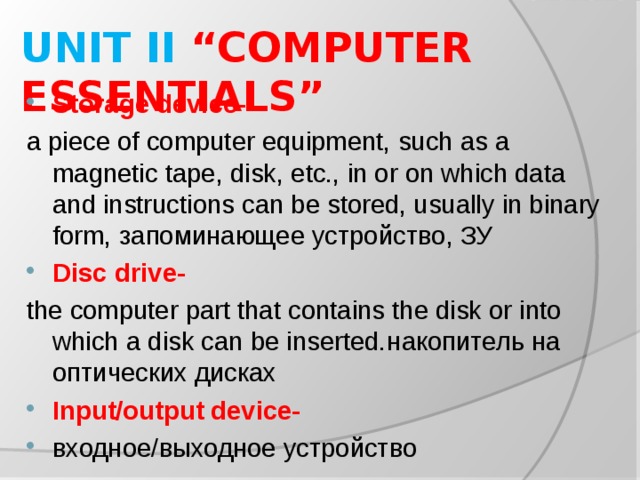
UNIT II “COMPUTER ESSENTIALS”
- Storage device-
a piece of computer equipment, such as a magnetic tape, disk, etc., in or on which data and instructions can be stored, usually in binary form, запоминающее устройство, ЗУ
- Disc drive-
the computer part that contains the disk or into which a disk can be inserted. накопитель на оптических дисках
- Input/output device-
- входное / выходное устройство
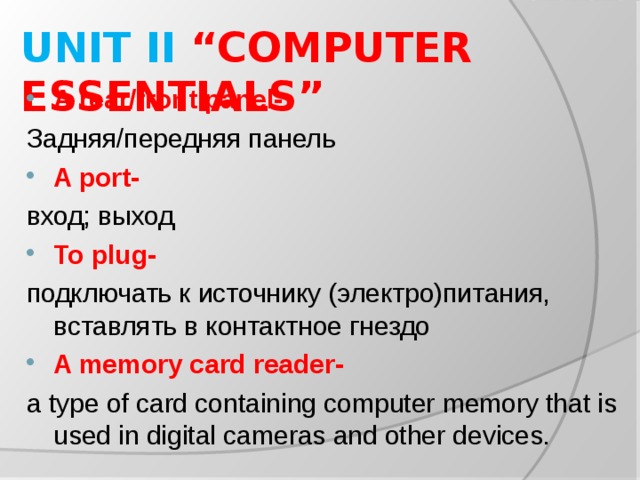
UNIT II “COMPUTER ESSENTIALS”
- A rear/front panel-
Задняя/передняя панель
- A port-
вход; выход
- To plug-
подключать к источнику (электро)питания, вставлять в контактное гнездо
- A memory card reader-
a type of card containing computer memory that is used in digital cameras and other devices.
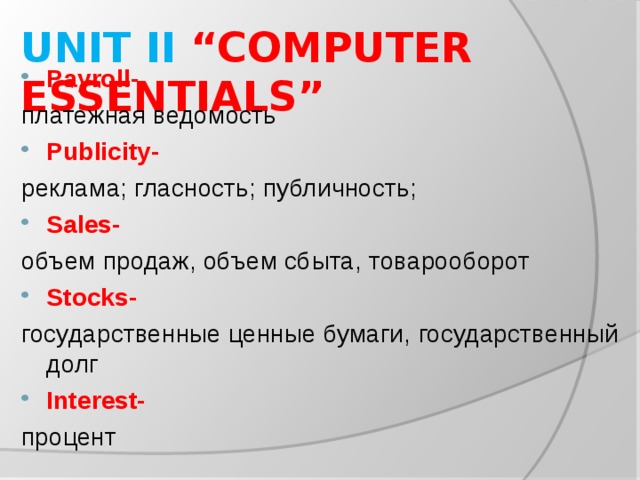
UNIT II “COMPUTER ESSENTIALS”
- Payroll-
платежная ведомость
- Publicity-
реклама; гласность; публичность;
- Sales-
объем продаж, объем сбыта, товарооборот
- Stocks-
государственные ценные бумаги, государственный долг
- Interest-
процент
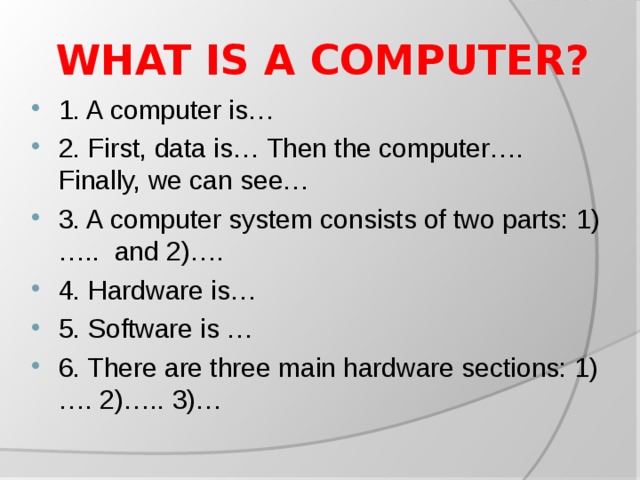
WHAT IS A COMPUTER?
- 1. A computer is…
- 2. First, data is… Then the computer…. Finally, we can see…
- 3. A computer system consists of two parts: 1)….. and 2)….
- 4. Hardware is…
- 5. Software is …
- 6. There are three main hardware sections: 1)…. 2)….. 3)…
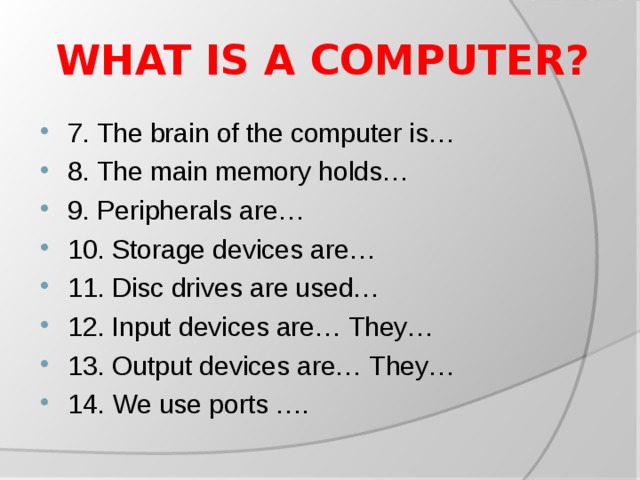
WHAT IS A COMPUTER?
- 7. The brain of the computer is…
- 8. The main memory holds…
- 9. Peripherals are…
- 10. Storage devices are…
- 11. Disc drives are used…
- 12. Input devices are… They…
- 13. Output devices are… They…
- 14. We use ports ….
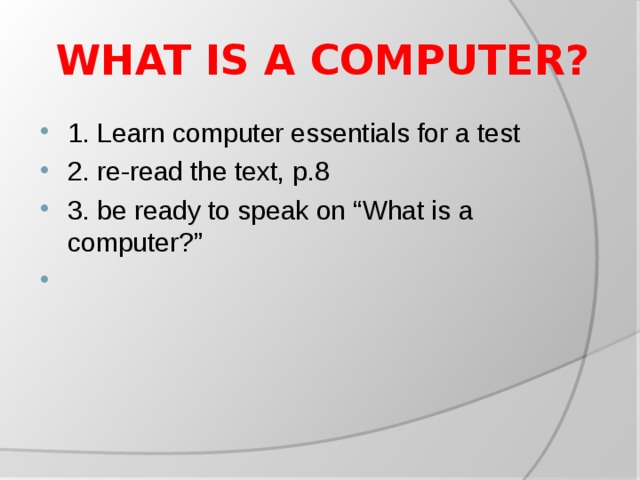
WHAT IS A COMPUTER?
- 1. Learn computer essentials for a test
- 2. re-read the text, p.8
- 3. be ready to speak on “What is a computer?”
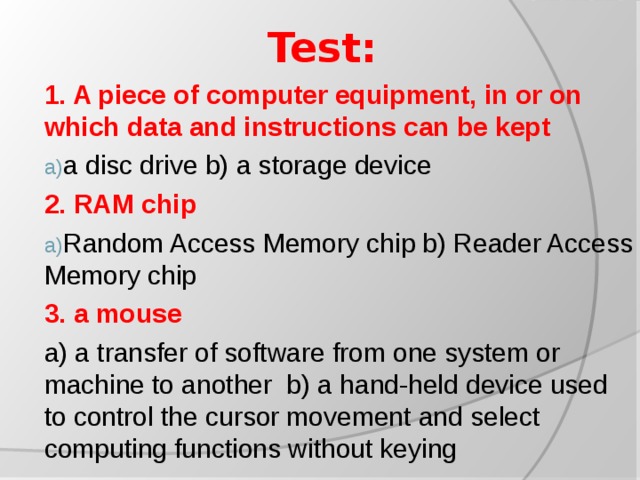
Test:
1. A piece of computer equipment, in or on which data and instructions can be kept
- a disc drive b) a storage device
2. RAM chip
- Random Access Memory chip b) Reader Access Memory chip
3. a mouse
a) a transfer of software from one system or machine to another b) a hand-held device used to control the cursor movement and select computing functions without keying

Test:
4. a part of the computer that processes all the data and makes the computer work
- CPU b) hardware
5. a piece of equipment which allows access to other computers or networks
- modem b) software
6. a panel that operate a computer or typewriter
a) a keyboard b) a mouse
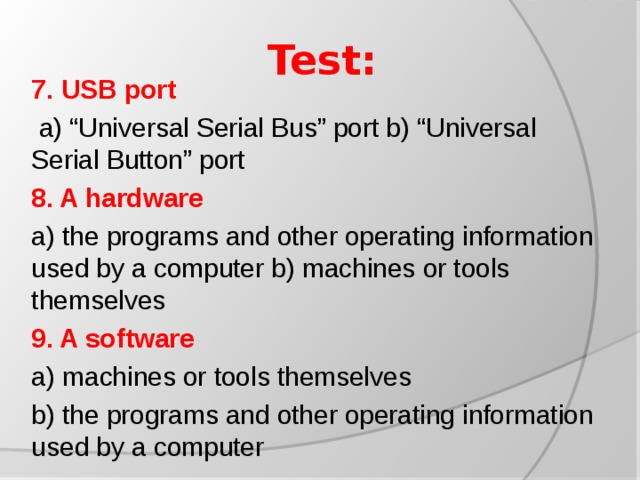
Test:
7. USB port
a) “Universal Serial Bus” port b) “Universal Serial Button” port
8. A hardware
a) the programs and other operating information used by a computer b) machines or tools themselves
9. A software
a) machines or tools themselves
b) the programs and other operating information used by a computer
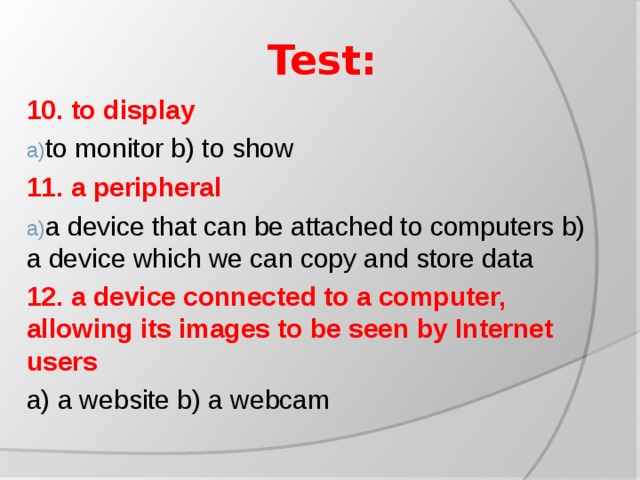
Test:
10. to display
- to monitor b) to show
11. a peripheral
- a device that can be attached to computers b) a device which we can copy and store data
12. a device connected to a computer, allowing its images to be seen by Internet users
a) a website b) a webcam
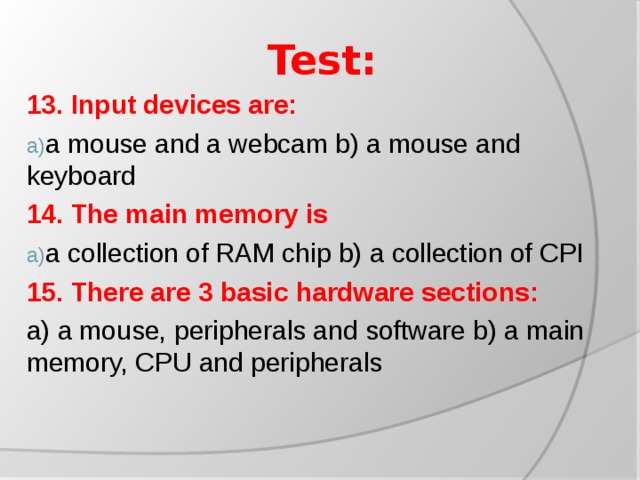
Test:
13. Input devices are:
- a mouse and a webcam b) a mouse and keyboard
14. The main memory is
- a collection of RAM chip b) a collection of CPI
15. There are 3 basic hardware sections:
a) a mouse, peripherals and software b) a main memory, CPU and peripherals
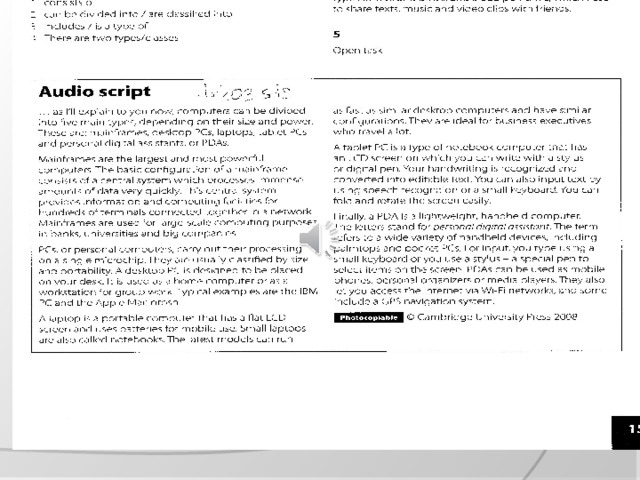
UNIT II “COMPUTER ESSENTIALS”

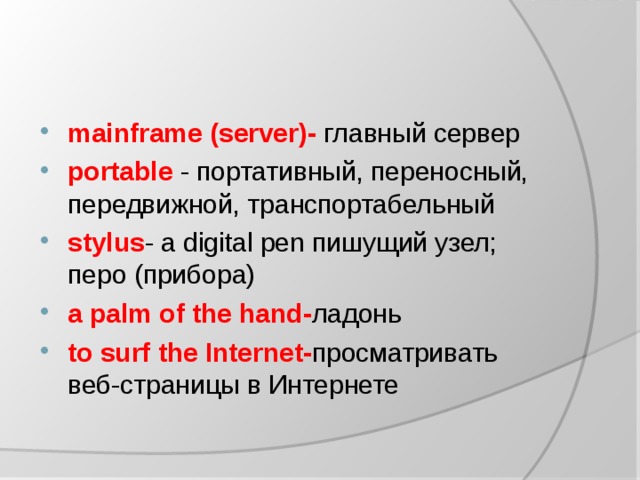
- mainframe (server)- главный сервер
- portable - портативный, переносный, передвижной, транспортабельный
- stylus - a digital pen пишущий узел; перо (прибора)
- a palm of the hand- ладонь
- to surf the Internet- просматривать веб-страницы в Интернете

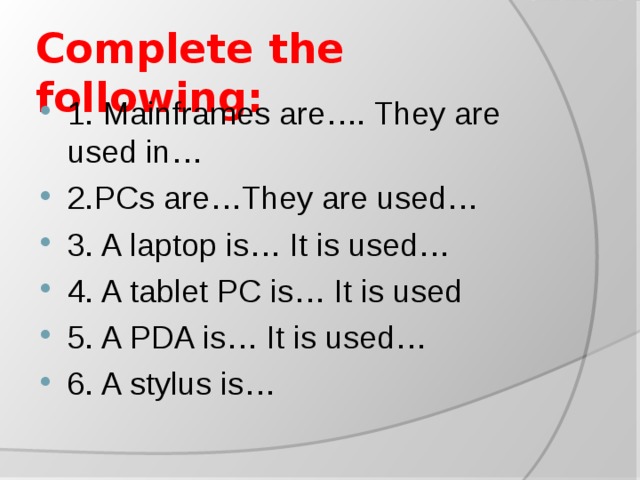
Complete the following:
- 1. Mainframes are…. They are used in…
- 2.PCs are…They are used…
- 3. A laptop is… It is used…
- 4. A tablet PC is… It is used
- 5. A PDA is… It is used…
- 6. A stylus is…

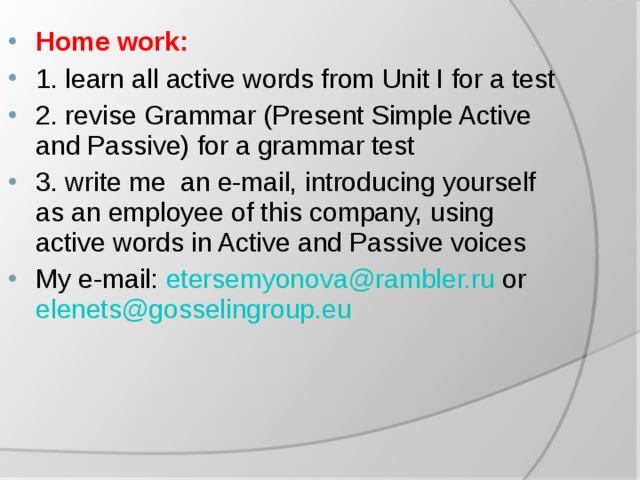
- Home work:
- 1. learn all active words from Unit I for a test
- 2. revise Grammar (Present Simple Active and Passive) for a grammar test
- 3. write me an e-mail, introducing yourself as an employee of this company, using active words in Active and Passive voices
- My e-mail: [email protected] or [email protected]
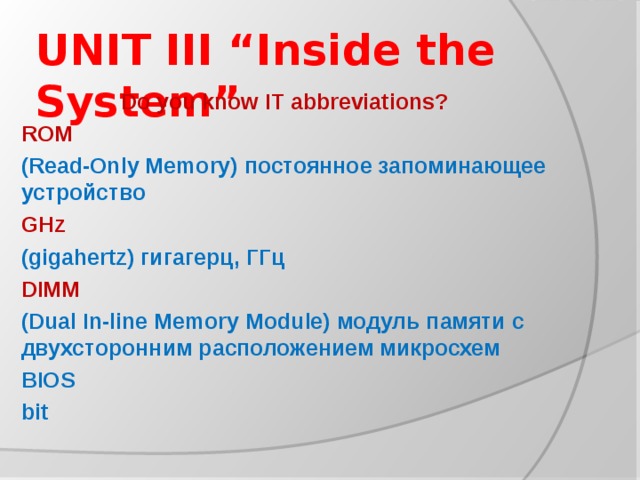
UNIT III “Inside the System”
Do you know IT abbreviations?
ROM
(Read-Only Memory) постоянное запоминающее устройство
GHz
(gigahertz) гигагерц, ГГц
DIMM
(Dual In-line Memory Module) модуль памяти с двухсторонним расположением микросхем
BIOS
bit
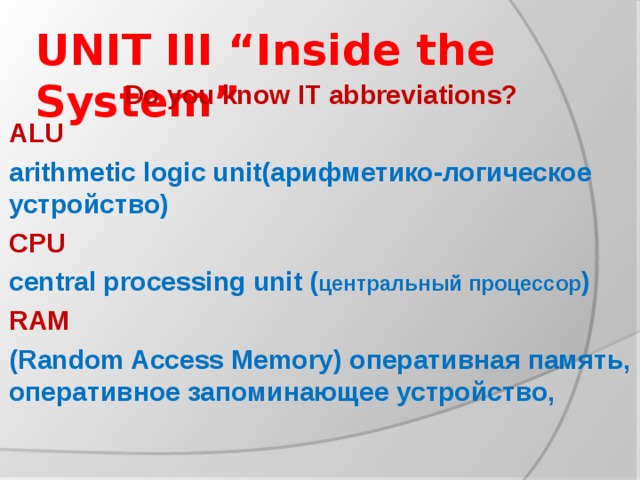
UNIT III “Inside the System”
Do you know IT abbreviations?
ALU
arithmetic logic unit(арифметико-логическое устройство)
CPU
central processing unit ( центральный процессор )
RAM
(Random Access Memory) оперативная память, оперативное запоминающее устройство,
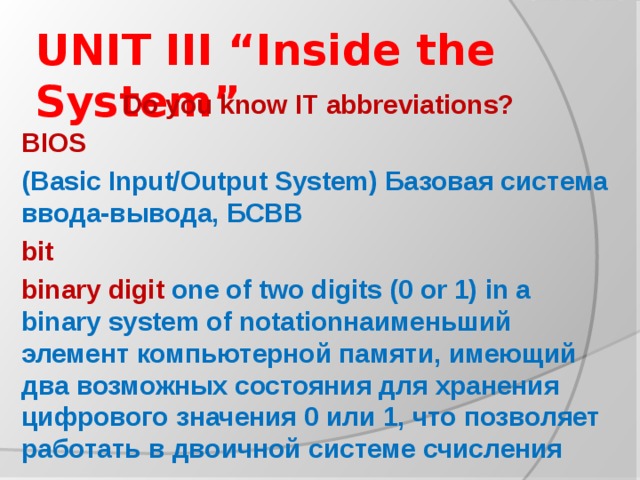
UNIT III “Inside the System”
Do you know IT abbreviations?
BIOS
(Basic Input/Output System) Базовая система ввода-вывода, БСВВ
bit
binary digit one of two digits (0 or 1) in a binary system of notationнаименьший элемент компьютерной памяти, имеющий два возможных состояния для хранения цифрового значения 0 или 1, что позволяет работать в двоичной системе счисления
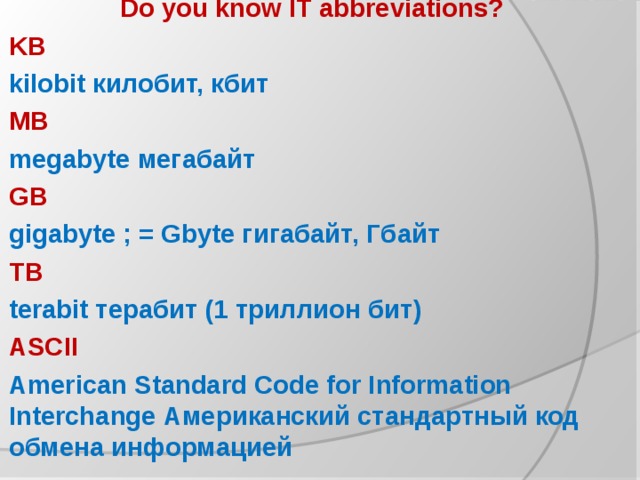
Do you know IT abbreviations?
KB
kilobit килобит, кбит
MB
megabyte мегабайт
GB
gigabyte ; = Gbyte гигабайт, Гбайт
TB
terabit терабит (1 триллион бит)
ASCII
American Standard Code for Information Interchange Американский стандартный код обмена информацией
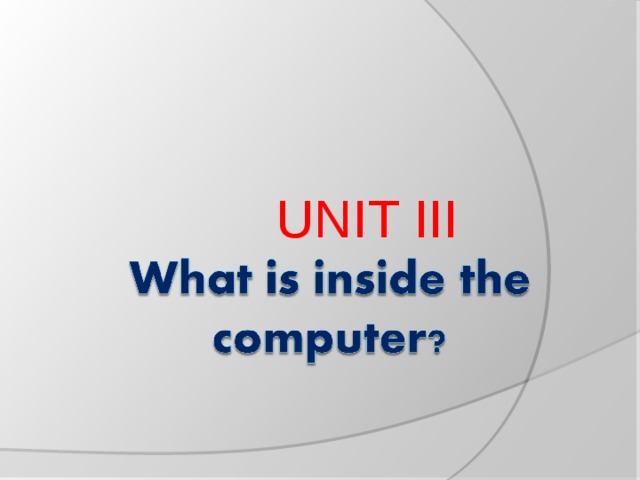
UNIT III
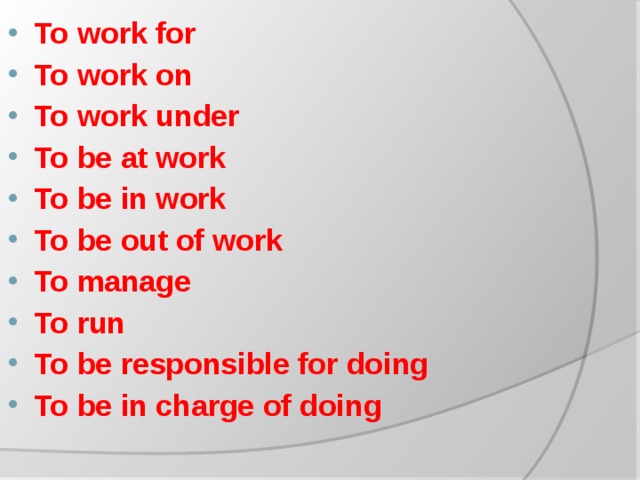
- To work for
- To work on
- To work under
- To be at work
- To be in work
- To be out of work
- To manage
- To run
- To be responsible for doing
- To be in charge of doing

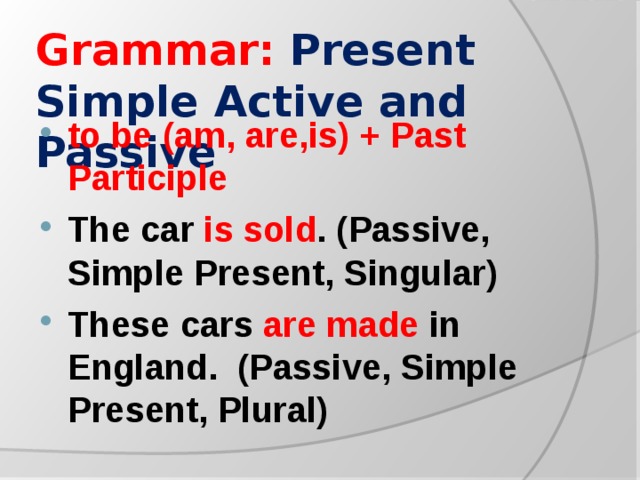
Grammar: Present Simple Active and Passive
- to be (am, are,is) + Past Participle
- The car is sold . (Passive, Simple Present, Singular)
- These cars are made in England. (Passive, Simple Present, Plural)
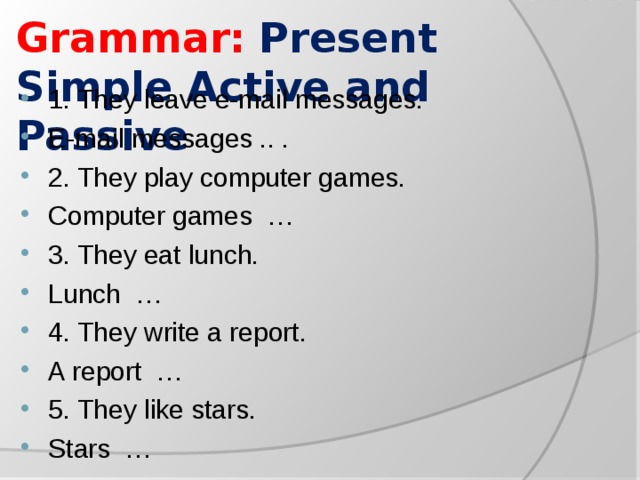
Grammar: Present Simple Active and Passive
- 1. They leave e-mail messages.
- E-mail messages .. .
- 2. They play computer games.
- Computer games …
- 3. They eat lunch.
- Lunch …
- 4. They write a report.
- A report …
- 5. They like stars.
- Stars …

Grammar: Present Simple Active and Passive
- 1. My best friend__ Ben. (to call)
- 2. Both films__ together (to put)
- 3. The dog__ . (to feed)
- 4. A lot of work __ for school. (to do)
- 5. Cars__ in factories. (to make)
- 6. The house __. (to build)
- 7.This room__ often . (to clean)
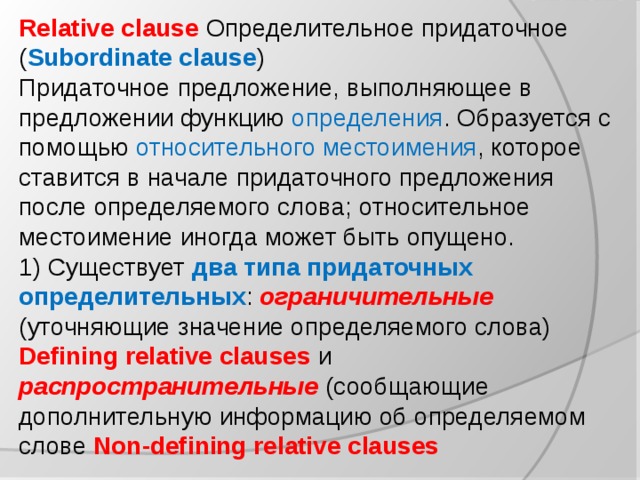
Relative clause Определительное придаточное ( Subordinate clause )
Придаточное предложение, выполняющее в предложении функцию определения . Образуется с помощью относительного местоимения , которое ставится в начале придаточного предложения после определяемого слова; относительное местоимение иногда может быть опущено.
1) Существует два типа придаточных определительных : ограничительные (уточняющие значение определяемого слова) Defining relative clauses и распространительные (сообщающие дополнительную информацию об определяемом слове Non-defining relative clauses
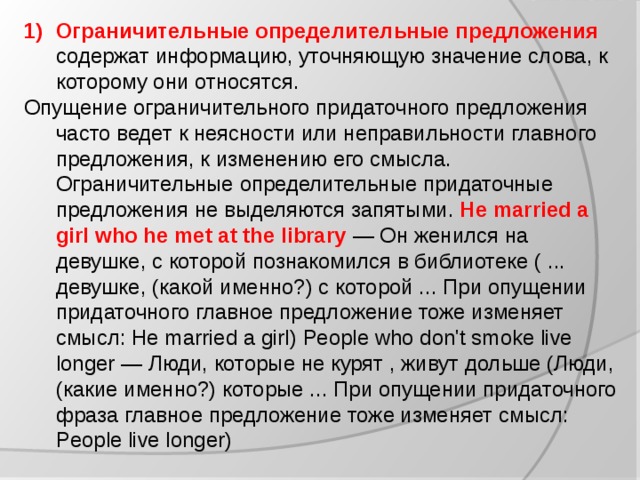
- Ограничительные определительные предложения содержат информацию, уточняющую значение слова, к которому они относятся.
Опущение ограничительного придаточного предложения часто ведет к неясности или неправильности главного предложения, к изменению его смысла. Ограничительные определительные придаточные предложения не выделяются запятыми. He married a girl who he met at the library — Он женился на девушке, с которой познакомился в библиотеке ( ... девушке, (какой именно?) с которой ... При опущении придаточного главное предложение тоже изменяет смысл: He married a girl ) People who don ' t smoke live longer — Люди, которые не курят , живут дольше (Люди, (какие именно?) которые ... При опущении придаточного фраза главное предложение тоже изменяет смысл: People live longer )

2) Распространительные определительные предложения содержат информацию, дополнительно характеризующую слово, к которому они относятся и которое достаточно определено само по себе, чтобы главное предложение не изменяло смысл при опущении придаточного определительного.
Такие предложения встречаются реже ограничительных; употребляются преимущественно в письменной речи. Распространительные придаточные, в отличие от ограничительных, выделяются запятыми. This is Mary, who was my classmate — Это Мэри, с которой я учился в одном классе (= с ней я ...) ( ... Мэри, (с какими еще свойствами?) с которой... При опущении придаточного предложения смысл главного сохраняется: This is Mary)
3) Между ограничительными и распространительными предложениями отсутствует четкое разграничение. Часто тип предложения определяется интонацией (распространительные предложения выделяются голосом), важностью информации в придаточном предложении (распространительные предложения содержат менее важную информацию) или тем, какая интерпретация более естественна.

Who/which relative clauses
- 1. This is the bank __ makes money transfer.
- 2. A men ___ manages this IT company is my neighbor.
- 3. The man ___ speaks English can get this job.
- 4. He is in a mask __ made him look like Mickey Mouse.
- 5. A DJ is someone _plays music in a disco.
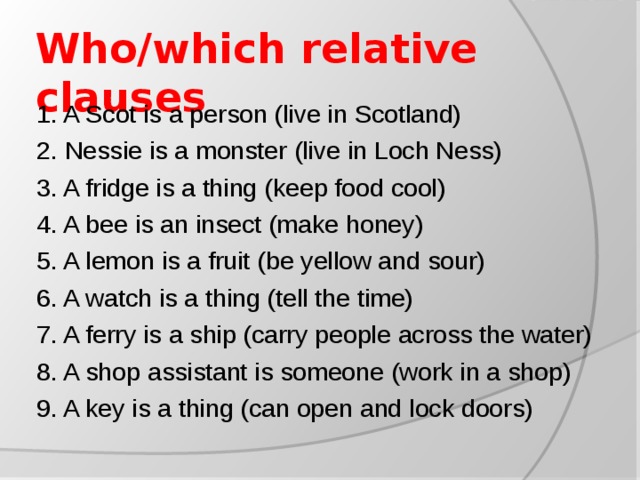
Who/which relative clauses
1. A Scot is a person (live in Scotland)
2. Nessie is a monster (live in Loch Ness)
3. A fridge is a thing (keep food cool)
4. A bee is an insect (make honey)
5. A lemon is a fruit (be yellow and sour)
6. A watch is a thing (tell the time)
7. A ferry is a ship (carry people across the water)
8. A shop assistant is someone (work in a shop)
9. A key is a thing (can open and lock doors)
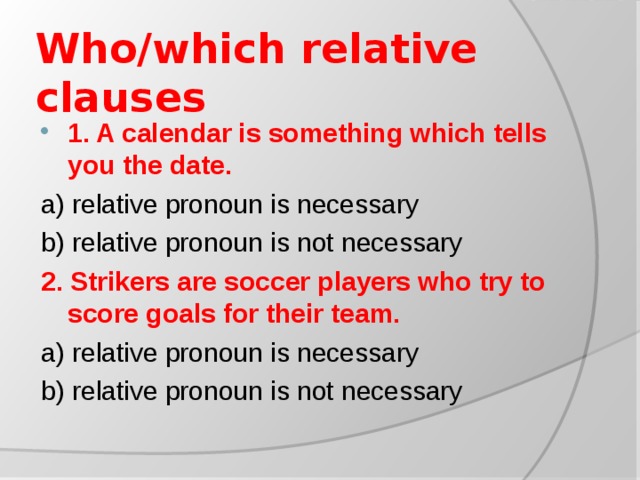
Who/which relative clauses
- 1. A calendar is something which tells you the date.
a) relative pronoun is necessary
b) relative pronoun is not necessary
2. Strikers are soccer players who try to score goals for their team.
a) relative pronoun is necessary
b) relative pronoun is not necessary
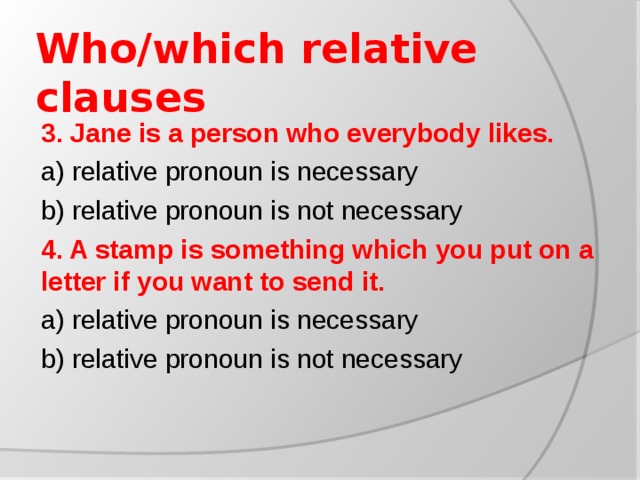
Who/which relative clauses
3. Jane is a person who everybody likes.
a) relative pronoun is necessary
b) relative pronoun is not necessary
4. A stamp is something which you put on a letter if you want to send it.
a) relative pronoun is necessary
b) relative pronoun is not necessary
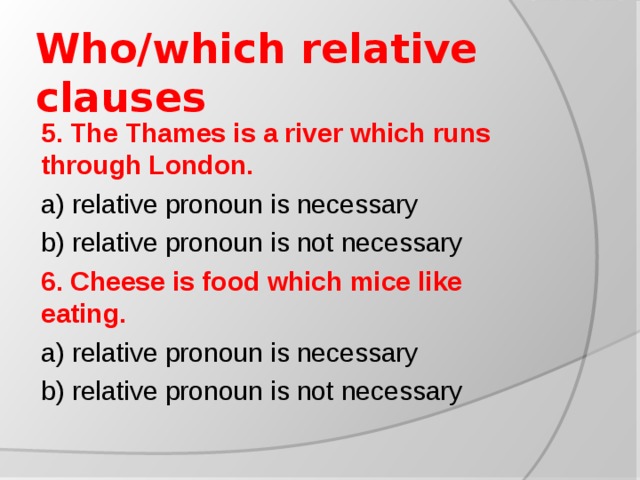
Who/which relative clauses
5. The Thames is a river which runs through London.
a) relative pronoun is necessary
b) relative pronoun is not necessary
6. Cheese is food which mice like eating.
a) relative pronoun is necessary
b) relative pronoun is not necessary
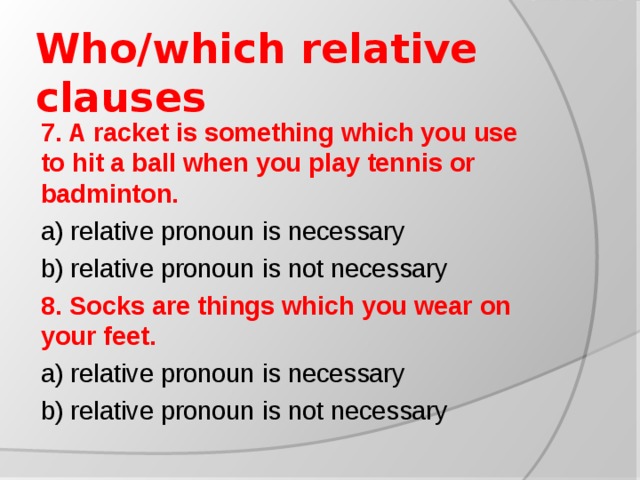
Who/which relative clauses
7. A racket is something which you use to hit a ball when you play tennis or badminton.
a) relative pronoun is necessary
b) relative pronoun is not necessary
8. Socks are things which you wear on your feet.
a) relative pronoun is necessary
b) relative pronoun is not necessary



